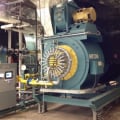Welcome! Here are the website rules, as well as some tips for using this forum.
Need to contact us? Visit https://heatinghelp.com/contact-us/.
Click here to Find a Contractor in your area.
If our community has helped you, please consider making a contribution to support this website. Thanks!
Cost of bad radiator traps?
Options

Mike_Sheppard
Member Posts: 698
Does anyone remember where in TLAOSH Dan mentions what the monetary loss can be of a bad steam trap? I know it's in there I just can't for the life of me find it. Writing report for a manager to show to their board.
Never stop learning.
0
Comments
-
Looked in the older version and I couldn't find it either. The way I look at it every gallon of water uses about 1100 btus to boil it plus with an 80% boiler you would add 220 btus so the total is 1320 btus for every pound of makeup water added/steam lost0
-
@EBEBRATT-Ed I know I've read it in these books somewhere. Maybe it was in @RayWohlfarth books. Still searching.Never stop learning.0
-
I've got a spreadsheet i use which is very accurate. I also have manual calculations which is what spreadsheet is based on.
Need orifice size, run time and some steam tables. Let me know and I'll send it to you.Peter Owens
SteamIQ0 -
Even if the steam is not lost to the atmosphere, the function of large sections of the system can be effected..A trap leaking into the returns can close down neighboring radiators.
In the case of leaking crossover traps, the whole system could be shut off.—NBC0 -
I was at a future customer site today. They are a heavy manufacturer of plastics. They had a site survey done recently and I looked it over.
They had a 650 PSIG thermodynamic trap, 3/16" orifice running 8760 hours a year, fully blowing by. $80,000/annually it said on survey. I don't have any way to verify those numbers since I don't know their therm cost.
I have a few TD traps under monitor which are 1,000 PSIG superheated steam right off turbines. Can't even imagine costs if those are failed.
But back to radiator traps, their orifice size can be larger than a F&T and when failed can be significant.
This is also helpful for quick calcs
https://www.energy.gov/sites/prod/files/2014/05/f16/steam1_traps.pdfPeter Owens
SteamIQ0 -
@Sailah that’s some serious stuff! Wish I could see some of that. What does a 1000 psi steam trap look like? Got any pictures?
I swear I read it in one of these books. I just can’t find it. If I’m remembering correctly it was over $200 per month per trap failed open. May be wrong. Don’t want to put it on paper before I verify it!Never stop learning.0 -
Mike i don't have pics that facility doesn't allow them. But it was a TLV trap i believe.
Re losses it really depends on therm costs, hours of operation and orifice size. Some traps like mepco have a huge seat, which is why i used them for big mouth. Others don't. If you tell me the trap and therm cost i can run the numbers for you to verify.Peter Owens
SteamIQ0 -
i don’t think there was any real # for how much $ it saves or costs but I would image that it would be in the 15 to 20 % saving on fuel but the hidden savings like getting heat where it should no more be overheating from steam blowing thru failed traps also less boiler short cycling on pressure and of course no pressurization of returns which we all know be be a hinge issue usually requiring some one to turn up pressure to get it to work .i don’t think I would guarantee much fuel saving being if it doesn’t work out they would have a hang man stand waiting for u ,I would use the angle that for proper functioning 2 pipe system that trap repair and replacement come w the system and that when traps go fuel cost go up and comfort goes down hand and hand . I personally kinda of gave up on that thanks less job been down the road and it seems building owners would rather give u there wifeand children then pay for trap repair or replace,ment . Unless the sky is falling maybe lol if you go down that road make sure u get every trap or the one u missed shall kick ur **** and possible destroy all your good deeds .if it’s that fargone and they continue to follow a no maintaince mantra then maybe look into doing orifice plates and rid ur self of traps but then u will need possible lower pressure and good guality steam .im sure u know all this but sometimes u need some one else to remind of your non building owner way in thinking that they will spend it usually is after the sky has fallen that your voice of logic will shine through but by then the hot air guy has been there offering his voodoo .guaremte them nothing except lower fuel comsumpition and comfort and remember in all likelihood those traps are 4 x the age of the owners car there’s a trail of where there money went . Peace and good luck clammy
R.A. Calmbacher L.L.C. HVAC
NJ Master HVAC Lic.
Mahwah, NJ
Specializing in steam and hydronic heating0 -
I don't think that's in my books. I had written an article many years ago, questioning an ASHRAE article that had come out. They were looking at losses through failed-open trap. They measured the $$$ loss by how much steam would pass through an orifice of a certain size, and they took that as a total loss, as if the steam was passing to atmosphere.
I questioned that because the steam isn't really lost when it goes though a failed trap; it's in the returns and still subject to condensing, so the heat would be released somewhere in the building. The article didn't mention all the problems having steam in the returns creates, but that wasn't the article's objective.
I contacted the author (a NYC engineer) and we talked about this. He agreed, and said that was about the best they (meaning ASHRAE) could do when trying to calculate how much a bad steam trap costs a building. He was on the phone at the time, but I could sense him shrug.
I know that doesn't help much, Mike, but the only true way to find out is to replace the traps and see how much energy they save. I don't think it's going to be astronomical, but the system will work as it should and last a lot longer, and that's really what matters. I you just go by how much steam will pass through the trap as if it's venting to the atmosphere, you can probably measure the ROI of trap replacement in hours, but that doesn't happen in real life..Retired and loving it.1 -
To me, measure make-up water convert to lbs of steam. Added make up water=lb of steam lost0
-
Yep, Dan hit the nail on the head and drove it home it one hit! When not too many traps are failed, it just releases heat into the building in the walls etc, and preheats the returning condensate. Outside of widespread trap failures ( which most buildings I've seen have) probably the biggest savings is in getting the system to heat evenly so average indoor temps can be reduced.To learn more about this professional, click here to visit their ad in Find A Contractor.0
-
If there is waterhammer which can be cured by fixing traps, the silence will be worth a lot of money.—NBC0
-
I agree about the few failed traps likely won't waste much. Here's an install we did last week in MA. When your tank is reading 100C though...the giveaway was the 2 old pumps laying on the ground.


And the vent stack is also reading 100C
And bonus points if you can tell me what's wrong here? This is dripping the main supply to the building.
The math changes dramatically if they don't take condensate back though. Like in NYC if it's ConEd, the building dumps the condensate so you really don't get much of the BTUs back.
Peter Owens
SteamIQ0 -
@Mike_Sheppard
I must disagree on the wasted heat and fuel comments by others
In most buildings with traps the "lost" steam is coming out of the boiler feed tank or condensate tank and isn't heating the building at all . It's dumping into the boiler room or mechanical room or in many cases is piped outside.
Defective traps also cause other traps to go bad, cause backpressure in return lines...can cause improper condensate draining resulting in frozen coils....damaged heat exchanger bundles etc.
Not to mention the damage to vacuum pumps and boiler feed pumps from overheated condensate0 -
yeah but there's a spot for a vent on the top , , ,known to beat dead horses0
Categories
- All Categories
- 87.3K THE MAIN WALL
- 3.2K A-C, Heat Pumps & Refrigeration
- 61 Biomass
- 427 Carbon Monoxide Awareness
- 119 Chimneys & Flues
- 2.1K Domestic Hot Water
- 5.8K Gas Heating
- 115 Geothermal
- 165 Indoor-Air Quality
- 3.7K Oil Heating
- 76 Pipe Deterioration
- 1K Plumbing
- 6.5K Radiant Heating
- 395 Solar
- 15.6K Strictly Steam
- 3.4K Thermostats and Controls
- 56 Water Quality
- 51 Industry Classes
- 50 Job Opportunities
- 18 Recall Announcements




